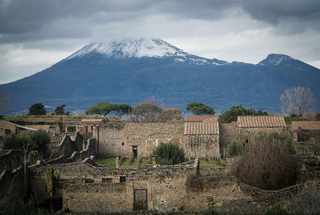n 79 A.D., Mount Vesuvius erupted, blanketing the nearby Roman towns of Pompeii and Herculaneum in hot ash and preserving the casualties in lifelike poses. And as awful as being smothered by ash may be, a new study suggests that suffocation wasn't the cause of death for many victims.
Archaeologists have found that some people perished in a pyroclastic surge, a wave of superheated gas and hot ash that literally boiled their blood and caused their skulls to explode, reports Neel V. Patel at Popular Science.
The evidence comes from boat houses in Herculaneum, a seaside resort town for wealthy Romans about 11 miles from Pompeii. In the 1980s and 1990s, archaeologists began uncovering the remains of several hundred people who had huddled in the shelters at the water's edge to wait out the eruption. For hours the volcano, which had not erupted for hundreds of years, shot ash and chunks of pumice into the air, causing many people to evacuate or to seek shelter in solid structures. But it appears that a flow of superheated gas rolled down the mountainside at hundreds of miles per hour and blindsided the people in the waterfront chambers.
Read Full Article »




